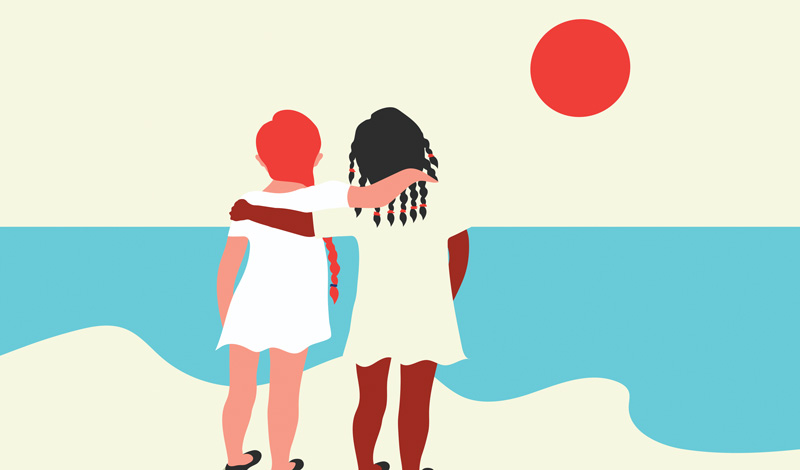One of English literature’s most enduring tales of friendship is about a spider and a pig. In Charlotte’s Web, Wilbur, a young pig, the runt of the litter, is saved by a kindhearted girl, only to be eventually shipped off to a farmhouse for slaughter.
There, Wilbur befriends Charlotte, a wise and compassionate gray spider, who weaves a plan, so to speak, to save her friend, ultimately at the cost of her life.
“Why did you do all this for me?” Wilbur asks Charlotte as she nears the end. “I don’t deserve it. I’ve never done anything for you.”
“You have been my friend,” Charlotte responds. “That in itself is a tremendous thing.”
Friendship is a fundamental aspect of being human. Yet nowadays, there seem to be fewer opportunities for deeper connection, a dearth felt most acutely by youth, who typically learn key life skills through friendships that shape their self-identity and resilience.
Ikeda Sensei says in Discussions on Youth about the importance of friendship:
There’s a Mongolian proverb “A hundred friends are more precious than a hundred pieces of gold.” People who have friends are rich. Quite often, the encouragement and influence of friends spur us toward self-improvement. We are inspired to lead fulfilling lives and to create a better world—to work together with our friends toward that goal. (p. 316)
In this month’s feature, we explore examples in literature of friendship and how they resonate with the Buddhist principles that teach us how to become human in the fullest sense of the word.
‘My friends have made the story of my life’
Helen Keller utters these words in her autobiography, which details her journey from isolation (having lost her sight and hearing while young) to one of learning, communication and then advocacy. She writes: “My friends have made the story of my life. In a thousand ways they have turned my limitations into beautiful privileges, and enabled me to walk serene and happy in the shadow cast by deprivation.”[1]
One of the friends of which she speaks is Anne Sullivan, a young teacher who, through incredible patience, perseverance and ingenuity, teaches Helen to read, write and speak. Ms. Sullivan goes so far as to accompany Helen to Radcliffe College, where she helps her student navigate the world to an eventual career in activism and public speaking.
In one early episode, Ms. Sullivan encourages her student to climb a tree. At first, Helen feels a deep sense of freedom and connection to nature. But as a sudden thunderstorm strikes, the branches lashing about her, she feels panic and isolation. At that crucial moment, Ms. Sullivan comes to her rescue and guides her to safety.
Nichiren Daishonin writes extensively about the importance of “good friends” in Buddhism, who help us strengthen our faith and character, especially in turbulent times.
In one letter, he tells his disciple:
When a tree has been transplanted, though fierce winds may blow, it will not topple if it has a firm stake to hold it up. But even a tree that has grown up in place may fall over if its roots are weak. Even a feeble person will not stumble if those supporting him are strong, but a person of considerable strength, when alone, may fall down on an uneven path. (“Three Tripitaka Masters Pray for Rain,” The Writings of Nichiren Daishonin, vol. 1, p. 598)
Even those who think of themselves as strong need support in life from time to time. In the same letter, he writes: “How far can our own wisdom take us? If we have even enough wisdom to distinguish hot from cold, we should seek out a good friend” (WND-1, 598).
Good friends pick us up and encourage us to keep moving forward when things get tough. They point out our potential when we doubt ourselves and challenge us when we are veering off track. A good friend in Buddhism leads us back to the Gohonzon, the writings of Nichiren Daishonin and Sensei’s encouragement, through which we can overcome anything. Such friendships aren’t transactional; they’re transformational.
‘I run to save my friend, who waits in my stead’ [2]
Osamu Dazai’s short story Run, Melos!, is a tale that revolves around the themes of friendship, loyalty and trust as well as selfless dedication to others.
In this story, a cruel and tyrannical king executes many people. The young shepherd Melos rises up against him and is apprehended and sentenced to death. Before his execution, he requests to return to his village to attend his younger sister’s wedding.
The king demands a hostage to remain in his place. Melos’ friend Selinuntius volunteers. Melos promises to return before sunset three days later. After the wedding, his return is blocked by a raging flood and bandits.
As sunset approaches on the third day, Melos gives in to exhaustion and starts to waver. Thinking of his friend, he rallies. “Someone waits for me,” he thinks. “I must prove worthy of his trust.”
He spurs himself on, arriving just in time to save his friend from execution. This friendship restores the king’s faith in human beings, and he spares both young men.
Sensei wrote about the bond between Melos and Selinuntius in The New Human Revolution:
Melos would have kept running to save Selinuntius even if, at the execution ground, Selinuntius had lost faith and denounced him. And even if Melos had decided to flee for his life, Selinuntius would have stood by him, praising his loyalty and assuming he had been killed somewhere at the king’s behest. …
The vow we make with a friend inspires us to stand alone and live up to our beliefs. When both do so, the most beautiful drama of friendship unfolds. (NHR-28, p. 93)
‘No man is useless while he has a friend’[3]
So said Robert Louis Stevenson who greatly valued friendship. One of his books, Memoir of Fleeming Jenkin, memorialized his dear friend, an engineer, professor and writer whose life was cut short by illness at age 52.
Although Stevenson is best known for his adventure novels Treasure Island and Dr. Jekyll and Mr. Hyde, this profoundly personal account emphasizes the power of friendship to transcend time and even death.
In the book, Stevenson describes their evenings together, engaged in animated discussions about literature, philosophy, science and life. Although their professions differed, he described their friendship as built on mutual curiosity, respect and a shared love for intellectual exploration.
Writing affectionately of his friend, Stevenson recalled, “There was something in Fleeming’s talk that touched the imagination; he seemed to live in and to communicate a higher sphere of thought.”[4]
Our friends can help us open up to new ways of thinking and being. As noted in Sensei’s words earlier, “Human beings only exist fully amid their relationships between one another.”
In the Buddhist canon, there’s a well-known exchange between Shakyamuni and his disciple Ananda, who asks him if having good friends and growing with them helps one attain half the Buddha way. Shakyamuni replied that, in fact, “having good friends and advancing together with them is not half the Buddha way but all the Buddha way” (The Wisdom for Creating Happiness and Peace, part 3, revised edition, p. 106).
What is the Buddha way? It is to continue bringing forth our inherent Buddhahood and expressing it through cultivating our humanity. The SGI is a gathering of individuals with this shared purpose.
Sensei writes: “Our organization exists to mobilize the spirit of human goodness—people’s desire to help and benefit others—and use it to create great value. You might say that the Soka Gakkai is a body or organism that took form and came to life specifically to bring together the basic goodness of people’s hearts, to further develop that goodness and strengthen it. Without the organization, there would be no cohesion or order to our efforts” (The Wisdom for Creating Happiness and Peace, part 3, revised edition, p. 106).
Gathering of Truly Good Friends.
The Soka Gakkai is a gathering of truly good friends, a harmonious realm in which individuals support and encourage one another as equals as we strive to do our human revolution and transform our lives and society.
Sensei defined supporting others as the practice of a bodhisattva and said that doing so actually heals our lives:
There are countless people in the world whose hearts have been wounded in some way. We need to extend a healing hand to such individuals. Through such efforts, we in fact heal ourselves.
When beset by some misfortune, people tend to think that no one could possibly be as unhappy or unlucky as they are. They feel sorry for themselves and become blind to everything but their own situation. They wallow in their suffering, feeling dissatisfied and hopeless, which only saps their life force further.
At such times, what gives someone the strength to go on living? It seems to me that it is human bonds—the desire to live for the sake of others. As long as we are wrapped up in ourselves, there is no happiness. When we courageously take action for others, the wellspring of our own life is replenished.
When we look after and care for others—that is, help others draw forth their life force—our own life force increases. When we help people expand their state of life, our state of life also expands. That is the wonderful thing about the bodhisattva way. The practice for benefiting others is one and the same with the practice for benefiting ourselves. (The Wisdom for Creating Happiness and Peace, part 1, revised edition, pp. 229–30)
Kosen-rufu and our peace movement is not just the narrow goal of developing our Buddhist organization. Kosen-rufu is a movement by which we come together in a united effort to enable all people to reveal their inherent potential.
In a world where individualism often takes precedence and there is a strong tendency to avoid direct interaction with others, cultivating good friendships and being a part of a network of good friends can feel counter to the times. But by having the courage to engage with others, in good times and bad, we can build a network of good friends that serves as a light of hope for the future.
The following experiences by Ben Lawrence (p. 19) and Liberty Lee (p. 21) highlight the profound impact that friendships and the SGI community have had on their lives. Ben and Liberty speak on the support given to them at crucial times and how it has helped them become a true friend to others.
The Circle of Buddhism
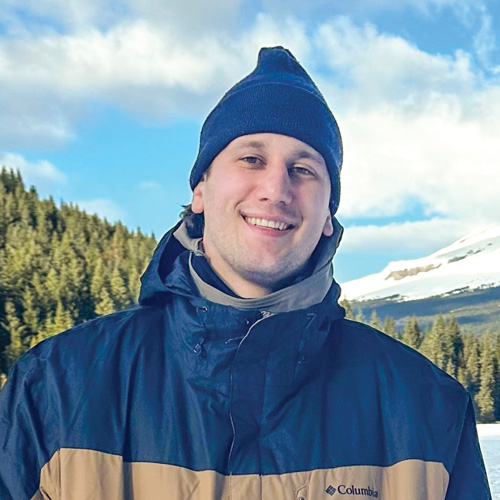
Ben Lawrence / Portland
Living Buddhism: Hi Ben! We heard you are a third generation SGI member but started practicing on your own about four years ago. What was the catalyst for that?
Ben Lawrence: I was at a low point in my life. Just five years ago, I was homeless, bouncing between friends’ couches, park benches and street corners. My days and nights entailed doing drugs and drinking. It was my escape from life. On the surface,
I had an “I got this. I don’t care” attitude. But inside I was angry at the world, which made me bitter and lost.
What ended up happening?
Ben: I’m sure my mom was always chanting for me. In fact, she was always checking on me, bringing me food when I had no money to pay for it. She encouraged me to chant but knowing that I would often get mad when she did, she didn’t push it. She was probably the only person who could see behind the mask I put on.
One day, I stumbled across a book at my grandparent’s home by Daisaku Ikeda. It was as though the book were written specifically for me. Ikeda Sensei articulated things so perfectly—things that aligned with what I already thought. It became clear to me that something important was missing in my life, something that could help me stay motivated and unlock my potential. I began chanting and felt its power.
When I was 19, the district young men’s leader, who had just moved to Portland from Japan, started calling me. And he wouldn’t stop. I wouldn’t pick up his call, and I would ignore him for weeks. He’d send me quotes from Ikeda Sensei and he would invite me to meetings. This went on for months. I was like, Why is this guy from Japan calling me all the time. I don’t even know him. But after several months, I gave in.
His spirit touched me deeply. It took courage for me to go to that first meeting with him, but I’m sure it also took courage for him to keep calling and texting me when I didn’t respond.
That’s incredible. What’s your relationship with him like now?
Ben: Now we do visits together, and I thank him all the time for never giving up and bringing me into this. I consider him a great friend. Really, the only way I can repay him is by taking on his spirit, Sensei’s spirit, and fostering others.
The other day I was telling him how difficult it had been to chant at my place because I had a friend staying over. He said: “I’ll stay up until you get off at 1 a.m. Come chant at my house. You just got to be a little quiet.” He has to get up at 6 a.m. but he has the heart and capacity to offer that to me. He really wants me to succeed, and I try to have that same heart to support others. Not just him, but I feel all SGI members have my back.
You know, the SGI community provides a support system that is made up of strong bonds. Those strong bonds make you want to be a better person at the end of the day. And you don’t have to focus just on yourself to become a better person. Supporting others brings so much light into your life.
It takes courage to be so vulnerable and open. Do you remember how you learned to be that way?
Ben: My discussion meetings provided that space for me to talk. I think it was as simple as hearing other people be vulnerable and feeling the courage to be the same. Because it is hard to initiate that, but that’s what’s so great about having districts with such a wide variety of ages and experiences.
I remember at one meeting, sitting in a circle, keeping my head down, not wanting to talk. And then someone says something so emotional. And then another person starts crying and then, all of a sudden, someone’s got a box of tissues and they’re handing tissues out. And then someone says something, and I’m like, Oh, I also feel that way. And now I have something bubbling inside that wants to come out. I get it off my chest and all of a sudden everyone’s clapping and I’m just like, Wow, that felt so good. And then I do it again, and I become more and more courageous.
The beauty of it is, it doesn’t end there. When you begin to open up in that way, to develop some confidence and self-worth, you start opening up to people that you meet at a bar or on a park bench. And then you find yourself sharing Buddhism with them. Then they start coming to meetings and then they feel empowered to be open and vulnerable.
That’s the circle of Buddhism. Seeking encouragement from others, finding courage within yourself, doing your best to give that encouragement to someone else and watching them bloom into their Buddha nature. I love seeing that happen—people unfolding petal by petal.
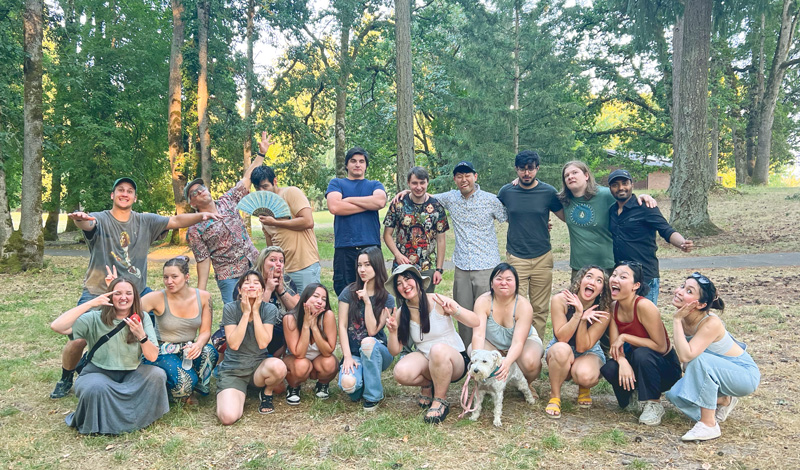
What do you think the SGI community has given you?
Ben: I think it’s self-worth and courage. When I was isolated from people who cared about me, I felt no one cared. Then, I started not to care. In terms of my goals and dreams, I didn’t want to strive for them because I had a lot of fear. It was easy to be afraid of failing when I didn’t have people supporting me. But to be a part of a community of people who seek to move forward in their lives, to better themselves and help others—that’s the beauty of the SGI community. You are not fighting alone. You have people who have your back at every moment.
How has your life changed in the last four years?
Ben: When I started chanting, the anger and bitterness I had felt disappeared. I had dropped out of high school at 17, so the first thing I did was get my GED. This allowed me to start classes at Portland Community College and start on a path that I never expected—to one day become a firefighter and then go to med school. I was able to obtain my EMT license from the state and now I work for the county as an EMT. I couldn’t be happier. I also have a great relationship with my father.
Now as a young men’s leader, I strive to be there for others like my SGI friends were there for me. I enjoy having dialogues with my friends about Buddhism, and many have attended meetings over the years.
It hasn’t been an easy road for me. In the beginning, there were steep ups and downs of getting really excited about chanting, then reverting to my old ways because I didn’t want to face my fears. But I’ve learned, with the help of my friends, to continue practicing when I feel down. It takes courage to do so—to chant, to study, to go to meetings when I feel like nothing is working, but that’s how I’ve built my capacity as a person who can live up to my potential and be there for others.
From This Moment Forward
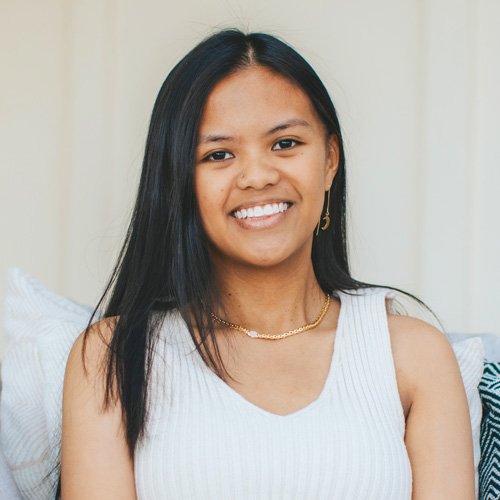
Liberty Lee / Los Angeles
Living Buddhism: Liberty, thank you for talking with us today. Your mother is a Buddhist and you grew up in the SGI community. What was that experience like?
Liberty Lee: My mother started practicing before I was born. She was introduced to Buddhism by two of her co-workers. My mom can be stubborn but somehow, they convinced her to start chanting. I am so grateful because it is one of the most beautiful things that my mom has brought into my life.
I was adopted. My parents brought me to LA when I was 9 months, and all of my SGI aunties welcomed me at the airport. They are really my family, always so supportive. No matter what I did, what grades I got in school, whatever sports I played or career I decided to pursue, they were always there, chanting for me, listening to me, supporting me.
When did you decide to chant on your own?
Liberty: I think it was when I started connecting with the young women’s leaders who were my age. We became friends and I wanted to attend activities because of them. Also, I had decided to start working for my dad, which was very challenging for me. It was one of the first things I started consistently chanting about. Of course, through chanting, I’ve transformed my relationship with him.
Did you find it easy to open up to your new friends in the SGI?
Liberty: I don’t like burdening other people with my problems, so I found it difficult to share what I was going through. It’s something I’ve struggled with my whole life. I’m usually the one supporting others, so it is uncomfortable for me to be supported.
When I think about a lot of my friends, I realized that they don’t actually know very much about me. So I challenged myself last year to open myself up more. I think the recent fires facilitated me opening my heart and truly accepting others’ support.
Your family had to evacuate during the Palisades fire. Can you tell us more about that?
Liberty: My family moved to the Pacific Palisades when I was 10, so that community is basically all I’ve known. On January 7, my mom stepped outside and saw flames at the top of our hill. The house where my best friend used to live was also on fire.
What did you do?
Liberty: With no hesitation, I told my parents they needed to grab the Gohonzon, their medications and other important items and we were getting out. In that moment, you really realize how much material things don’t matter in life.
They went inside to grab their essentials and we were out of there in 10 minutes. We each took our own car to get out. We got the emergency alert once we had already left our home.
I live almost two miles from Sunset Boulevard, which is the only way out. The drive to get to Sunset is usually two minutes. That day, we sat in traffic for about three hours.
Going down the hill through the canyon, I could see that the fire had split. The flames were blazing on top of both hills. I was chanting the entire time that the fire didn’t come down the hill because if it did, we would have had no other choice but to abandon our cars and run.
While in the car, I got a call from the recently appointed region young women’s leader. I don’t think I had ever had a full conversation with her before then. She had just moved to the area, and we had only done Byakuren together a couple of times.
What moved me the most is that she stayed on the phone with me for two hours. At one point I was really panicking, wondering if we would get out, whether I would have to get out of my car and walk down the hill if the smoke got closer, whether I would survive the smoke inhalation if I did. She was there for me and reassured me over and over that everything would be OK.
On that drive, many other SGI members also called to check on me. They were the first people to contact me. People were checking maps, finding the fastest way for me to get out of the Palisades. Words can’t describe how thankful I am to have this community.
When I got out of the area, I drove to the SGI-USA center, which opened as a relief site within hours of the fire starting. There were several families there who had to evacuate. It was comforting to be there together with everyone—people who were going through the same thing.
That must have been very frightening. Have you been back to the Palisades since?
Liberty: I went back a couple weeks after the fire. It made it very real, to see it with my own eyes. It was all gone. My house, almost miraculously, is still standing. All of the houses across the street and behind us are all gone, but our house and a few next to us are still standing. Of course it isn’t inhabitable right now, but we are extremely lucky. The entire community is devastated, but in some ways, I feel that my real community was strengthened—the bonds of friendships that I have with the members of the SGI.
For a week and a half following the fire, I was going to the Buddhist center almost every day. My friends in the youth division met me there and stayed with me until the center closed at 8:30 every night. Some of my friends even took time off from work to be there for me.
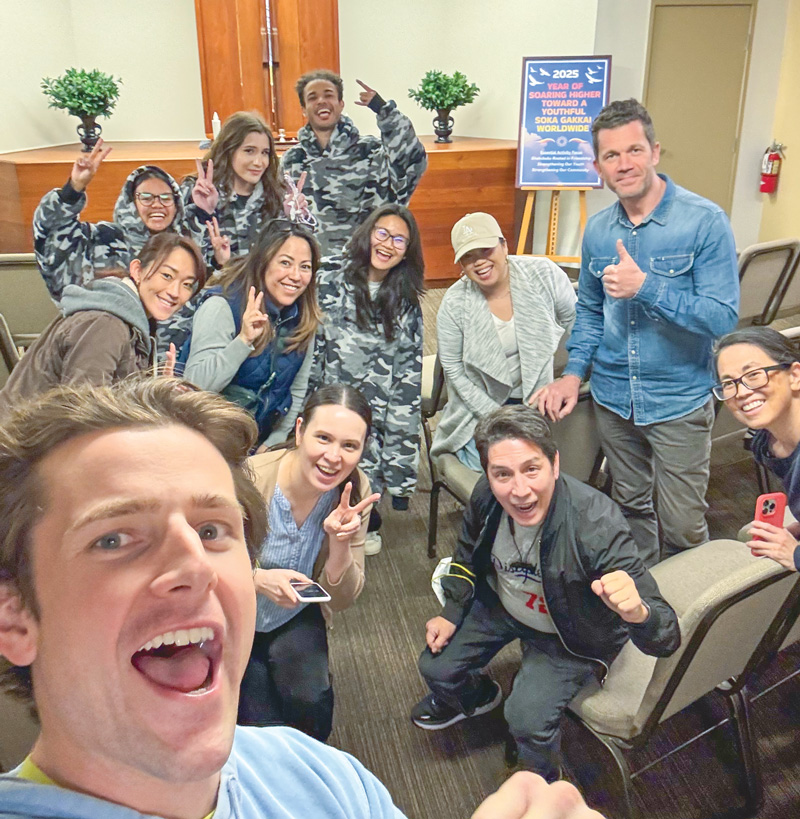
There is a long road to recovery for your community. What are you taking away from this?
Liberty: Members in the SGI, people I’ve never talked to in my life, people who I’ve know my entire life, came together to support on a whole different level at this crucial time. It really solidified how much I value this organization and how much I value this community.
I also gained perspective on material things. They don’t matter much. The most important thing in life is friendship and the ties I have to others.
Any parting thoughts and determinations?
Liberty: On my mirror at home, I have a note that reminds me that everything is from this moment forward, a concept that I learned in Buddhism. As a child, I had the tendency to dwell on things that happened in the past, wondering how I could fix or change it.
Because of my Buddhist practice, I’m able to ask myself what I can do from this moment. What do I value? How am I going to make the world a better place? I think that it all starts with my family, my friends, my community and being a global citizen. I want to be an even stronger pillar of support for those around me.
From the March 2025 Living Buddhism
References
- Helen Keller, The Story of My Life (New York: Doubleday, Page & Company, 1903), p. 140. ↩︎
- Osamu Dazai, Run, Melos! and Other Stories (Tokyo: Kodansha Publishers, 1988), p. 123. ↩︎
- Robert Louis Stevenson, Lay Morals and Other Papers (New York: Schribner, 1911), p. 50. ↩︎
- Robert Louis Stevenson, Memoir of Fleeming Jenkin. (New York: Cassell and Company, 1888). ↩︎
You are reading {{ meterCount }} of {{ meterMax }} free premium articles

